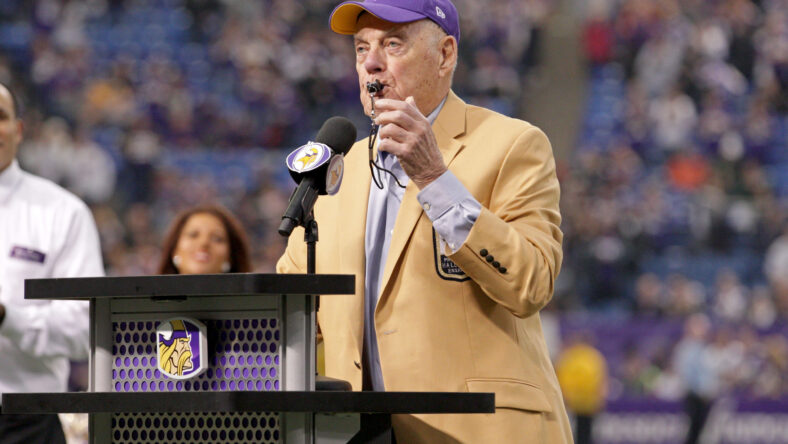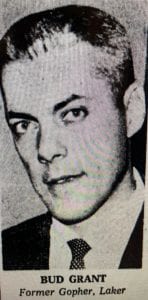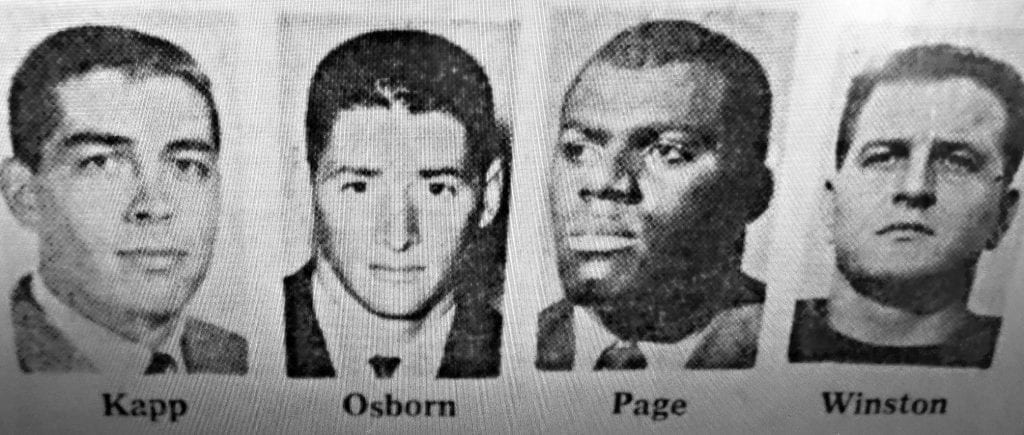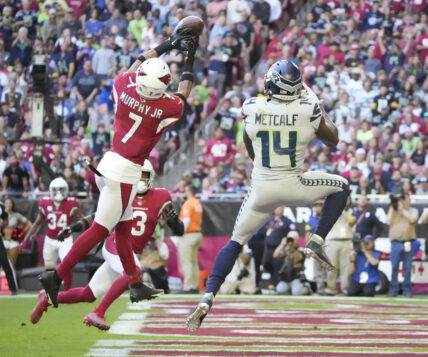The Vikings Win for Bud Grant

Grant’s First NFL Win Came at Vince Lombardi’s Expense
Part II of a Nine-Part Series on the First Win of Every Vikings Coach
When the 1966 season ended, the Minnesota Vikings were 4-9-1 and on a fast track to nowhereland. Norm Van Brocklin had alienated many Vikings’ players, and at various times over the years Van Brocklin called his players “stiffs” and “dogs,” saying “high school kids scrapped harder” than his players. Fran Tarkenton told management that he wanted to be traded: He ‘d lost that loving feeling, exhausted by Van Brocklin’s endless bitching about the way Tarkenton played quarterback. Six seasons with the Dutchman produced one winning season and an overall record of 29-51-4. Van Brocklin didn’t wait to be fired. He quit on Feb. 11, 1967.

The Minneapolis Star ran this photo of Grant in the paper’s March 11, 1967 edition.
A month later, Vikings general manager Jim Finks hired 39-year-old Bud Grant, an effective coach in the Canadian Football League who had won four Grey Cups while compiling a 102-56-2 record in 10 seasons. Young Bud sprouted in Superior, Wisconsin, and blossomed into a fluid, multisport athlete at the University of Minnesota. From 1946 to 1949 at the U, Grant earned eight letters: four in football, three in basketball and one in baseball. He left the U for the Minneapolis Lakers where he became an NBA champion when the Lakers won the title in 1950. Two years later, Grant became the NFL’s second leading receiver by making 56 catches (997 yards) for the Philadelphia Eagles. Decades before the American sporting public gawked with marvel at the multisport athleticism of Bo Jackson and Deion Sanders, a skinny kid from Superior had already been there and done that.
Grant’s athleticism had a feline grace. You could see it in his walk: He moved with the subtle ease of a tiger thinking about getting lunch, and those cold blue eyes had the penetrating power of a crouching cheetah scoping out an unwary wildebeest. Grant was economical with his words and emotional as a statue. His mind was also feline fast. He saw, borrowing from William Wordsworth, into the life of all things football, blessed with the skill to distill the complexities of football players, teams and schemes. The Vikings needed someone who was comfortable with himself and confident in his approach; a coach who was a cool cat. “The job sought the man,” Finks said on the day Grant was hired.
On March 11, 1967, the date of his hire, Grant had seen one Vikings game in his life (on television), but he knew he had the competence to create a winning nucleus with what was on the Vikings roster. “We can be a contender in a short while,” Grant told Minneapolis Star writer Jack Goodwin. “The Vikings have been going through a growing stage. Now they are ready to assert themselves.”
Optimism shines over every new coach. But four games into his first NFL season, few Vikings fans remembered Grant’s March assurances. Though the Vikings were 0-4, they had only been blown out in one game, a 39-3 loss to the Rams in Week 2. But losing was losing, and it was getting old. In an Oct. 8, 1967, home game against the St. Louis Cardinals, the Vikings led 24-13 with seven minutes left in the fourth quarter, but lost 34-24. Fans were already grumbling that if things didn’t change, Metropolitan Stadium would soon be renamed Grant’s Tomb.
THE BUILD UP
Straight ahead, winning didn’t look probable for Minnesota, not with Vince Lombardi standing on the other sideline. The reigning NFL champion Green Bay Packers had not lost in 17 games (16-0-1) dating back to the Vikings’ Nov. 6, 1966, upset in Green Bay. The 20-17, come-from-behind Vikings win was the bright spot in Van Brocklin’s last march with Minnesota. But with the Oct. 15, 1967, game in Milwaukee’s County Stadium looming, odds makers didn’t like Minnesota’s chances: Green Bay was favored to beat Minnesota by 20 points. At least.
Though the Packers were 3-0-1 and leading the NFC Central, there were whispers that the bloom was off Lombardi’s rose. Fourteen players on the 40-man roster were at least 30 years old, and the Packers got off to a creaky-knees start. In their opener, an 84-yard catch and run by Elijah Pitts in the waning moments led to a 17-17 tie with Detroit. They were sloppy in their Week 2 game against Chicago, needing a 46-yard field goal from Don Chandler in the final moments to beat the Bears, a game in which the Packers turned the ball over eight times. They next beat Atlanta 23-0, a newer team that still had that new car smell, but the Packers played their best game of the year in Week 4 at Detroit, winning 27-17.
In their messy win against the Bears, Green Bay quarterback Bart Starr was injured and would miss his third straight game when the Vikings and Packers met in Milwaukee.
During the week of the game, writer Don Linder of the Rapid City Journal interviewed Grant, who said, “Green Bay has a reputation for solid, relentless football. They have an excellent defense and they exert pressure through their defense. The Packers greatest attributes are poise and patience. They wait confidently and force you to try a non-percentage (higher risk) play. They let the opponent do the gambling. To win you must be as patient as they.”
Patience appeared to be central to Minnesota’s game plan against Green Bay. “I’m going to be as patient as possible,” quarterback Joe Kapp told Dick Gordon of the Minneapolis Star. “The Packers don’t give you much. So you’ve got to take what little they give you.”

The Minneapolis Star ran this photo in Gordon’s preview story.
Grant told Gordon, “The Packers look every bit as tough as we anticipated. Offense sells tickets but defense wins games and their defense has been great. Their linebackers have been outstanding and I’d say a lot of their defense is predicated on their linebackers and they do the job.”
At their last practice before the Packers game, Grant kept his offense on the field an extra 20 minutes to work on plays inside the opponent’s 20-yard-line, an area we know today as the red zone. And Kapp, making his second start, spent extra time working on timing patterns—handoffs and swing passes—with his running backs. Collisions between Kapp and his backs in the St. Louis collapse embarrassed the organization.
The day before the game, editors of the The Daily Journal of Fergus Falls Minnesota tried to prep their readers for disappointment with this Saturday headline: “Vikings Really Outclassed vs. Packers on Sunday.” The story mentioned the Packers had outscored their four opponents 80 to 44, while the Vikings had been outscored 55 to 117.
Packers defensive end and team captain Willie Davis wasn’t fooled by the Vikings 0-4 start. “They are adapting to a new coach and … they have improved every week,” Davis told the Appleton Post-Crescent on the day before the game. “They’re getting more points on the board and they’re moving the ball better. And each week, as he continues to learn the system, Kapp should get better.”
In one of the most prescient statements Davis ever made, he concluded: “We feel like [the Vikings] are a coming ball club.”
The Sunday morning papers in the Twin Cities carried final pregame stories. “Green Bay lets you do the gambling and it’s tough to gamble against their defense,” Grant told Merrill Swanson of the Minneapolis Tribune. “Green Bay is a winning team and it expects to win. Even in the fourth quarter and a team is ahead, the pressure is on them and not on Green Bay.” Swanson hinted that Grant had his team psychologically ready to beat the Packers, concluding his story with, “A number of veterans were overheard telling themselves they were going to beat Green Bay.”
THE FIRST HALF
Game day dawned cold, wet and gray in Milwaukee. By kickoff in the early afternoon, it had warmed to 56 degrees. Green Bay Press-Gazette writer Lee Remmel called it a “dreary day. … A cold drizzle before kickoff fell throughout the game and increased at the start of the third quarter.”
The first quarter was a punt fest between Bobby Walden of the Vikings and Donny Anderson of the Packers. Between them, they punted 15 times during the game, with Walden making one more punt than Anderson.
In the second quarter, the Vikings had the Packers pinned at their 14-yard-line when quarterback Zeke Bratkowski hit Carroll Dale at midfield and Dale outraced Karl Kassulke and Earsell Mackbee to the end zone.
Other than that play, the Vikings kept Green Bay guessing. They blitzed eight times in the first half. “We wanted to keep them honest and concerned about our blitz,” said assistant coach Bob Holloway. “By doing so, they were forced to keep two backs in the backfield to block. Instead of five receivers going out, they could only throw to three.”
After the Bratkowski-to-Dale bomb, the Packers got the ball right back on a poor Kapp throw. Linebacker Lee Roy Caffey tipped Kapp’s pass and Herb Adderley intercepted, returning it to the Minnesota 34. Another touchdown here might snap the fragile will of the winless Vikings, but Minnesota’s defense rose. Donny Anderson was thrown for a four-yard loss on first down. On second down, Bratkowski connected with Dowler for 15 yards but that gain was nullified by an illegal motion penalty. Fullback Ben Wilson was held to two yards and a Bratkowski to Anderson pass left Green Bay three yards shy on fourth down. Chandler’s 34-yard field goal attempt missed. Barely. “I hit it excellently,” Chandler told Remmel. “It was probably a couple of feet outside, but it was straighter than a string all the way.”
This became an important defensive series for the Vikings.
The Vikings kept it simple on offense. They never passed inside their own 20-yard-line and throughout the game, Kapp kept feeding the ball to fullback Bill Brown (24 carries for 72 yards), and halfback Dave Osborn (19 carries for 79 yards). The Vikings managed one first down in the first half. But they knew that while patience might cost them yardage, it would keep them in the game. Chandler’s 34-yard miss with 13:04 remaining in the second quarter was the last scoring threat of either team in the first half. The Packers led 7-0 at the break.
THE SECOND HALF
The rain picked up in the second half but the Vikings offense did not. Brown and Osborn continued to ram into Green Bay’s top-rated defense. Though they did not snap off huge gains and only crossed into Green Bay’s territory once in the first three quarters of the game, they were content to eat clock with a first down here and there, punt and play field position. Minnesota’s defense was stuffing Lombardi’s ground game and though the Vikings gave up passing yards, Green Bay’s 7-0 lead didn’t expand. Stay patient. Keep it close.
And, the Packers were busy beating themselves. Green Bay made plays on offense in the third quarter, but often those healthy gains were cancelled by penalties. A clip by Pitts nullified Boyd Dowler’s 29-yard reception. Later in the quarter, an offensive interference call negated a big gain to the Vikings 40.
On the last play of the third quarter, in what became a trademark of Bud Grant-coached teams, the defense made a play that turned the game. Cornerback Ed Sharockman leaped in front of Green Bay receivers Dowler and Bob Long at the Vikings 26 and took his interception all the way down to the Green Bay 37.
Sharockman’s play stoked the offense. On first down, Brown dipped outside left tackle and went for a 14-yard rumble to the Green Bay 23, at that point Minnesota’s longest gain of the day. Six plays later, in a vicious collision, Packers safety Doug Hart whacked Kapp down six inches short of the end zone after Kapp bootlegged off left tackle. Two plays later, the Vikings faced a fourth-and-goal at the Green Bay 1. Lineman Grady Alderman ran out to the 20-yard-line asking Grant what he wanted to do. Grant wanted six points. Brown banged the ball in from the 1. After Cox’s conversion, it was 7-7 with 11 minutes left in the game.
The Packers drove to midfield in their next possession, but the Vikings forced Green Bay to punt. The Vikings took over on their 8 and ran six straight running plays instead of airing it out after getting a first down on their own 20. “Normally I like to throw the ball more,” Kapp said. “I kept running to the sideline to ask Coach Grant if we could loosen it up and all he would say is ‘Nope.’” On a fourth down, Walden hit a 54-yard line-drive punt where Willie Wood was tackled on the Green Bay 12.
Green Bay managed a first down. Bratkowski dropped back, looking for Pitts along the sidelines near midfield. Vikings tackle Paul Dickson shed Green Bay guard Gale Gillingham, and Dickson and Jim Marshall were coming hard on Bratkowski’s blind side. Bratkowski barely got this pass away but cornerback Earsell Mackbee made a huge play, racing over to snag Bratkowski’s pass, dragging his feet and sliding out of bounds. An official ran up and signaled Mackbee’s catch was true. His interception affirmed, Mackbee spiked the sky by tossing the ball high in the air. View it here: https://www.youtube.com/watch?v=9A8AIt0HAvQ
Smelling upset, the Vikings’ offense sprinted onto the field. Osborn bit off two yards, and then took Kapp’s pass—it was only Kapp’s second completion in 11 attempts during the game—for 11 yards and a first down. On the sidelines, the Vikings were jacked, especially after Osborn sprinted 21 yards off left tackle down to the Green Bay 11. The Vikings kept it on the ground, making seven yards, the last run, a 1-yard position plunge by Brown, set up kicker Fred Cox.
With 13 seconds left, Cox drilled it from the 12-yard-line and moments later, Grant and his Vikings walked off the soggy sod of County Stadium as winners. Grant walked across the field to shake hands with Lombardi, but the choleric coach refused to shake Grant’s hand.
POST-GAME REACTION
As quiet as the Green Bay locker room was after the game, Minnesota’s was loud and proud. “Green Bay ran the play three times earlier in the game,” Mackbee said of his second interception. “In tight situations, they like to go back to plays that were open but they failed to execute. Ed (Sharockman) was behind (Pitts) and I was inside of Pitts, who was near the sideline.” Asked why he threw the ball in the air after he the official ruled his catch good, Mackbee said, “I knew it meant victory.”
Bratkowski said his three interceptions were the difference in the game; he credited Mackbee for a great play on Bratkowski’s final throw: “I was trying to keep it toward the sidelines—away from an interception. And he went over and grabbed it. It looked like he made an excellent play on it. I didn’t think he could get it. But he did.”
Linebackers Lonnie Warwick and Roy Winston made deep drops when the Packers passed, forcing Bratkowski to lob the ball into small hula-hoops of space near his receivers. “The game plan was perfect,” Warwick said. “We blitzed at first and we kept changing it around. I think the Packers were a little confused. They didn’t know what we were going to do.”
Grant was composed in the Vikings locker room after the game, but he was obviously happy. He continued to coach in his postgame comments: “We had our best inside pass rush from the line,” Grant said. “The linebackers did their best tackling of the season. They played the type of football I’ve been counting on.” His team, Grant said, was not afraid of Lombardi’s Packers. “The Vikings are not awed by the Packers, physically or otherwise. Maybe because of the geographical closeness. Some Eastern teams that play the Packers maybe every two years wonder what will Green Bay do to us. The Vikings take a different attitude: What are we going to do to Green Bay?”
The answer, at least on Oct. 15, 1967, was to beat Green Bay at its own game. “What we didn’t want to do is help Green Bay win,” Grant said. “We didn’t want to make a mistake in our end of the field. Green Bay turns those into quick points. We didn’t want any risks.”
Rookie Alan Page had a strong game as did his fellow tackle Dickson. Ends Carl Eller and Marshall made life difficult for offensive tackles Forrest Gregg and Bob Skoronski. Bratkowski was sacked twice for 13 yards in losses. Kapp was not sacked at all. The Vikings ran three more plays than the Packers (56-53) and shut down Green Bay’s ground game; the Packers rushed the ball 26 times for 42 yards while the Vikings rolled up 158 yards on the ground in 45 attempts. The commitment to the run enabled the Vikings to keep the game clock running and to wear out Green Bay’s defense. It collapsed enough after Mackbee’s second interception to allow the Vikings to drive down for a chip-shot field goal.
The next morning, Merrill Swanson used a 39-word lead to tell his Minneapolis Tribune readers the Vikings had taken an important step: “The Minnesota Vikings rose from the depths in gloomy, rain-swept County Stadium Sunday to bludgeon the world champion Green Bay Packers 10-7 and atone for a series of fumbles and bumbles that had resulted in four straight losses.”
Back in Green Bay, the Press-Gazette headline succinctly announced: “Vikings Upset Packers 10-7 on Interception, FG.”
Press-Gazette sportswriter Len Wagner had the unpleasant task of writing a sidebar on Lombardi’s reaction to the game. Wagner made little effort to hide Lombardi’s mood. One can see the great coach stewing in the reality of a loss to a team that had not yet won, simmering in fresh defeat, sarcastic, eyes flickering with contempt at questions: “Neither one of us had an offense worth a damn,” Lombardi said. “But [Minnesota] played real well. They stopped us every time we had to go.” Asked about the big play of the game, Mackbee’s second interception, Lombardi said, “It was a poor route, and everything.” Wagner mentioned that the 86-yard touchdown pass from Bratkowski to Dale was the longest play in the careers of both players. “Wonderful,” Lombardi snapped. “We’ve got the longest pass. Now we’ve got something to go back to practice to talk about.” When someone in the room mentioned that the Vikings had snapped Green Bay’s 17-game unbeaten streak, Lombardi fumed, “What difference does that make?”
1967 season ended well for Lombardi. The Packers went on to win the NFC Central Division with a 9-4-1 record. Their first playoff game, a 28-7 victory over the heavily favored Los Angeles Rams, led to the NFC championship on New Year’s Eve day against the Dallas Cowboys, who were also favored. Green Bay, as everyone knows, won what became known as The Ice Bowl in dramatic fashion, 21-17. Two weeks later, the Packers won their second straight Super Bowl over the Oakland Raiders. The Packers’ 1967 NFL Championship was their third straight, a feat unequaled before or since. It took Green Bay 29 years to return to a championship game.
The Vikings meanwhile, finished 3-8-3 in 1967. The following season, the Vikings won their first NFC Central Division title with an 8-6 record, one of 11 the Vikings won under Grant’s leadership. When Vince Lombardi and Bud Grant pitted their teams against one another on Oct. 15, 1967, Green Bay’s loss to Minnesota was a minor pothole on Lombardi’s golden journey into legend. For Grant and the Vikings, however, it was the first shared winning experience for what Willie Davis correctly called “a coming team.”
EXTRA POINTS
A total of 49,061 fans witnessed Grant’s first NFL win, which was then a record for a Packers game at Milwaukee’s County Stadium. Vikings fullback Brown predicted, in print, that Minnesota would beat Green Bay. Kapp made his first completion on his seventh pass attempt. The Vikings gained 3.5 yards per rush; the Packers averaged 1.7 yards on the ground. Bratkowski went 15-for-25 through the air for 240 yards. Kapp had as many interceptions (2) as completions in the game. “I just followed Mr. Grant’s game plan to set up the running game,” Kapp said. “I almost wrecked it by throwing those interceptions.”
NFL offenses had 45 seconds between plays in 1967 as opposed to 40 seconds today. Speaking of 2018 NFL football, Mackbee’s exuberant toss after his second interception likely would have drawn an unsportsmanlike conduct penalty. Notre Dame rookie Alan Page made his second career start against the Packers. “Page is a quick-footed man of 270 pounds,” defensive coach Bob Holloway told Sid Hartman. “He stayed down a lot better than he did against St. Louis. They don’t know how to play him yet and that helps.”
In the rematch in Minnesota on Dec. 3, 1967, the Vikings scored 10 points in the fourth quarter to tie the Packers at 27. However, Kapp fumbled the ball away to Packers safety Tom Brown at the Minnesota 28. A few plays later, Chandler made a 19-yard field goal with eight seconds left in the game to give Green Bay a 30-27 win.
Editor’s Note: Following the unfortunate news that Bud Grant has passed away, PurplePTSD has decided to re-post this article. This piece was originally posted on April 7, 2018.

